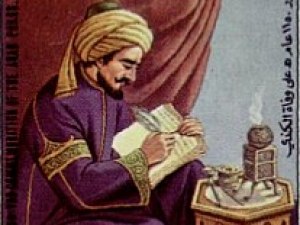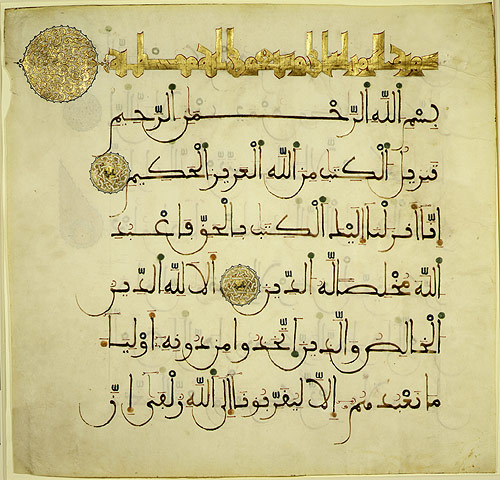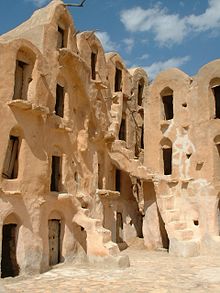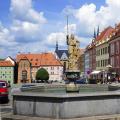Introduction
arabic world science
The medieval culture of the Arab East (V-XVI centuries) means the culture of Arabia and those countries that underwent Arabization and in which the Arab people developed - Iran, Syria, Palestine, Egypt and other countries North Africa... Later, the Arabs subordinated to their influence the Volga Bulgaria and the countries Central Asia.
There was also treatment for mental illnesses, which in Christendom were still considered Satanic things. The same chemical term comes from Arabic. Islamic civilization gave chemistry the character of science using observable procedures and experiments. Important texts have been written on this topic. In addition, Arab chemists knew about the distillation of sulfuric acid.
The Arabs developed a pharmacology based on mineral remedies. This treaty explained the structure and relationship of the eye and the brain, as well as eye disease and healing. It is also known that Arab doctors controlled ocular cataracts. In agriculture, the Islamic civilization has developed irrigation systems. They developed botany by classifying plants into genera, species, and classes. Muhammad said: Let the man examine his food! We have poured out water in abundance; The land was then deeply crushed and made to grow grains, vines, vegetables, olive trees, palms, lush orchards, fruits, pastures to delight you and your flocks.
Throughout the vast territory of the Caliphate, whose powerful uniting force was Islam, a new culture arose, which reached an unprecedented flowering in the 9th-11th centuries. Guided by the call of the Quran to seek new knowledge and study nature for the sake of discovering the signs of the Creator, inspired by the found treasure ancient greek wisdom, Muslims created a society that in the Middle Ages was the scientific center of the world.
In addition, noticeable botanical gardens and then imitated in Europe. They also incorporated new cultures unknown to Europe and spread them all over the place. These cultures have Arabic names to this day, like apricot, Swiss chard, carob, artichokes, saffron, spinach, watermelon, peas, carrots, lemons, oranges, acorns, sugar, cotton, jasmine, yellow violet, eggplant, etc.
The first zoo in Europe was Spanish Arabic. Other areas include sociology, philosophy, music, and textiles. In sociology, the Arabs rethought the past and the meaning of history, expanded the biblical perspective, thanks to which the origin of races was literally accepted after Noah, and they were devoted to the systematic study of the peoples of the world. Not only was this knowledge created through his cosmopolitan culture, but also through access to Greek and Latin texts. And among His signs, says Muhammad, is the creation of heaven and earth, the variety of your languages and your colors.
Medieval Islamic culture was a very complex phenomenon, which included a revised heritage of antiquity, the work of Arab inventors, scientists, philosophers, artists, and the huge contribution of representatives of various peoples of Western and Central Asia and the Mediterranean.
From the very first steps of the new religion, the caliphs made the acquisition of secular knowledge, the development of science, technology, art one of the requirements of Islam. The flourishing period of Islamic culture is characterized by a rapid rise in all areas of science accessible to the human mind of that era. In Muslim countries, philosophy, mathematics, astronomy, historiography, linguistics, chemistry, pharmacology, the art of healing and the art of speech flourished. The language and alphabet of the Arabs and Persians gave the world unforgettable monuments of prose and poetry. This was the era when brilliant philosophical treatises and works in the field of exact and humanitarian sciences were created.
There are in this, yes, signs for those who know. In philosophy, an Arab could read in his language to Plato, Aristotle, or any other Greek sage. In music, Muslims included the music of the countries in which they spread and created new musical instruments and styles.
The school considered music, like the Greeks, a branch of mathematics. V textile industry they developed the silk industry which originated with the Chinese. They also developed the paper industry, also from the Chinese. In metallurgy, they have produced works of art in various metals such as copper and bronze. Gold and silver were not used mainly due to the religious prohibition of their use in dishes, ascribed to Muhammad by oral tradition. It is important to note that they have taken the glass industry to an unprecedented level.
Reasons for high development Arab culture
One of important features Muslim civilization - the rulers, fighting against gentiles and pagans, nevertheless, did not forbid scientists to use the knowledge obtained from the books of Greek, Indian, Chinese authors.
As a result of the wide spread of Islam across the planet - from India to Spain - Muslims acquired more and more new knowledge. Persian and Indian scholars played a large role in the scientific and linguistic deciphering of ancient Greek manuscripts. The knowledge of scientists was very important, since it not only served to increase the intellectual potential of the empire, but also brought practical benefits in various fields: from monumental architecture and urban planning to medical care and transportation.
Islam revolutionized the world of antiquity. It would be impossible to compile a detailed listing of all of Islam's contributions to western world... What has just been described may be an isolated example that revolves around shared and greater social commitment.
Antonio Alcala Galiano, in his History of Spain, wrote that for the specific mention of the names of all the authors of Arab Spain to those who speak of the numerous catalogs that still exist in one large library, there would be a company that would require separate and extensive work. This article has attempted to describe a general list of the most important contributions of Islam to the Western world and, in particular, to the Latin American world. As you know, the Arabs developed a remarkable civilization during the eight centuries that they were in Spain.
Wide trade provided rich material for mathematical problems, long travels stimulated the development of astronomical and geographic knowledge, the development of the craft contributed to the development of experimental art. Therefore, new mathematics, convenient for solving computational problems, originates in the East. In the VII-X centuries. there was a rapid development of the natural and exact sciences among the peoples that were part of the Arab Caliphate. The centers of medieval Arab science were the cities of Baghdad, Kufa, Basra, Charon. Under the caliphs Harun ar-Rashid and Al-Mamun, scientific activity experienced a period of upsurge: astronomical observatories were built (in which observations of heavenly bodies were carried out), buildings for scientific and translation work, and libraries. By the X century. in many cities, secondary and higher Muslim schools - madrasahs - appeared. In some cases, teachers were well paid. Even special travels were undertaken for educational purposes.
This civilization not only made Spain the intellectual center of the ancient world, but also significantly shaped the cultural development of Spanish society, thus creating a social symbiosis. With the rise of Catholic kings, the Arabs were driven from the peninsula, causing the decline of Spanish society due to the lack of an intellectual class that was accepted by the Arab community. Almost immediately, America was invaded by Spanish troops, and as a result, the crown ruled for almost four centuries. This article proposes the thesis that the influence of Islamic culture in Spain was passed on to Latin American culture indirectly through the process of transculturalism that originated from Spain into its colonies.
The concept of Arab culture and its content
The term "Arab culture" is sometimes extended to all those cultures that were created in the Middle Ages, both by the Arab peoples and by the peoples of the Near and Middle East, North Africa and South-Western Europe, who were then under the rule or under the direct influence of the Arab Caliphate. Common outward sign all these cultures were Arabic. Arabs creatively assimilated the culture the ancient world- Greco-Hellenic, Roman, Egyptian, Aramaic, Iranian, Indian and Chinese, having adopted it from the conquered or neighboring peoples with the participation of peoples subordinate to them - the Syrians, Persians, Khorezmtsi (now Uzbeks and Turkmens), Tajiks, Azerbaijanis, Berbers, Spaniards (Andalusians) and others. The Arabs took an important step in the development of a common human civilization.
Alcala Galiano, Antonio, History of Spain. Western society tends to believe that the scientific and cultural base where he sits is a product of the classical world, especially the Romans and Greeks. In our schools, professors shout out explaining Latin etymology, talking about the contributions of Euclid, Pythagoras, Plato and Aristotle. They remind us of the inventions of these sages and claim that knowledge of ancient classical culture has shaped our own learning universe.
But, in our obsession with the Romans and Greeks, we are dazzled by the full panorama. We forget how knowledge came to our libraries, our universities and our own leaders. We forget how the development of classical culture formed the basis of modern Western civilization.
The cradle of Arab culture was Western, Tse Central and Northern Arabia. Arab culture was preceded by the culture of the population of South Arabia, who spoke the Sabean language and had their own written language. Arab culture has undergone both the influence of this culture and the culture of the regions of Asia Minor and Egypt, where part of the Arabs settled in ancient times, as well as the culture of the Aramaic population of the regions of present-day Syria, Lebanon, Palestine and Iraq. Somewhere in the 4th century, the Arabs already created their own letter writing, which was one of the varieties of Aramaic cursive writing. In the 7th century, an Arab theocratic state was formed in Arabia, which, through conquests until the middle of the 8th century, grew into a large feudal empire - Arab Caliphate(see Baghdad Caliphate), which included Iran, Afghanistan, part of Central Asia, Transcaucasia and Northwest India, the countries of North Africa and a significant part of the Iberian Peninsula (Andalusia). Arab feudal lords planted Islam and the Arabic language in the conquered countries. Some of the countries they conquered were Arabized, others retained their cultural and linguistic independence, but the Arabic language in these countries was used in science, like Latin in medieval Europe. Centers for Arab culture in different time there were Damascus, Baghdad, Cordoba (see. Cordoba Caliphate), Cairo and other cities. In the 9th-10th centuries, characterized by scholars as the "era of the Muslim Renaissance," the leading centers of culture were Bukhara and Khorezm.
We usually deceive ourselves in transferring knowledge: it's not as simple as we usually believe. In fact, the knowledge of the classical sages passes through a matrix, a certain system that defines and shapes them, just like iron is forged and takes on the body of a sword. As usual in the history of mankind, the lines are not straight, but zigzag.
Now, for the first time, historians are reevaluating the method of scientific thinking that has evolved up to this point, focusing on how one big advance is driving another, in both the West and the East. For the first time in the West, Extraordinary Arab Contribution Agreements have been negotiated that have allowed the world we live in to emerge as we know it today.
After the collapse of the caliphate (VIII-X centuries)- this artificial conglomerate of peoples with different levels of development, held mainly by the military force of the Arab conquerors, - the development of Arab culture in the newly formed Arab states ah and the culture of the liberated not Arab peoples continued under the influence of growth in production and exchange. The decline of Arab culture began in the 16th century after the conquest of most of the Arab countries by the Turks. In the 19th-20th centuries, European civilization, which conquered and turned into its colonies the countries of the Arab East, became a brake on the development of the culture of the Arab peoples.
Without this, most of the technologies we know and want will simply not exist. The plane that brought me to Chile did not take me off the ground. There would be no hospital that kept me alive in my first week of life. Or technology that allows me to store this printed sheet.
There were no glass sheets in the windows; Moreover, the technology that powers our computers and shapes our lives today, simple and simple, will not exist. During this time, the fire of the earth spread over the earth; the flames that quickly dissipated, just as the limits of the Islamic faith expanded in all directions. This was the time when the first hospitals and libraries were built and the first academic degrees appeared. Patients with mental disorders were first treated with music - more than a thousand years before the current idea of music therapy.
Arab Science
Arab science at the beginning of its history developed under the influence of ancient Greek science and under the influence and in interaction with its contemporary highly developed science of the peoples of Central Asia, Transcaucasia, India, Persia, Egypt, Syria.
The further development of Arab science was conditioned by the needs of production and military affairs, to which the Arab conquerors attached great importance. Arab science, like Arab culture in general, was concentrated in a network that was wide enough at that time. educational institutions... School education emerged after Arab conquests when Arabic spread as the language of administration and religion. Elementary schools at mosques (mektebs or kyuttabs) have existed since the 8th century.
An endless catalog of inventions was created in the training centers, which over time became a model for the western concept of the university. The Arabs invented chemical devices, hydraulic and pharmaceutical systems, astronomical instruments, and even washing powders. They wrote about the concepts of evolution, environment and pollution, and for the first time sketched a scientific method such as the idea of "peer review". They formed the constructive foundations of our own scientific culture and rethought all kinds of problems that are important today in the modern world.
With the development of philological and natural sciences in the Baghdad Caliphate, and then in other Arab states, scientific and educational centers arose: starting from the VIII century, grammar schools in Basra, Kufa and Baghdad. Academy established in Baghdad in 830 "Dar al-ulum"("House of Sciences"). In 972, a university was founded in Cairo al-Az-gar... Education reached a high level of development in the Arab-Pyrenean lands. In the 10th century, in Cordoba alone, there were 27 madrassas, where they taught medicine, mathematics, astronomy, and philosophy.
It was through them that we got the newspaper, "Arabic numerals" and a huge mathematical progress with the concept of zero. The Arab contributions of the Golden Age cover almost all sciences. They can be found in mathematics and botany, chemistry, psychology and philosophy, engineering, physics, agriculture and astronomy, metallurgy, medicine and zoology.
The cores of virtually all the technologies that govern our lives have passed through Arab cultures - from tires Vehicle up to the clocks on our wrists, the satellites that television gives us and the mechanism that makes the Internet possible. In this reading, a photograph will be presented on the role of Arabic science, which would allow for the Renaissance, which finally shaped our modern world.
The historical merit of the Arabs is that they, having adopted the achievements of science of ancient times, developed it further and passed on to the peoples of the West, thus becoming, as if a bridge between antiquity and modern civilization. The works of Euclid, Archimedes and Ptolemy became known to Western Europe thanks to the Arabs. Ptolemy's work "Megale syntax" ("Great construction") is known to Western Europe in Arabic translation as "Almagest". Having an idea of the sphericity of the earth, the Arabs in 827 in the Syrian desert measured the arc of the meridian to determine the size the globe, corrected and supplemented astrological tables, gave names to many stars (Vega, Aldebaran, Altair). Observatories existed in Baghdad, Samarkand and Damascus. Having borrowed the Indian digital system, Arab scientists began to operate with large numbers, from which the concept of "algebra" originated, first used by the Uzbek mathematician Al-Khorezmi (780 - † 847). In the field of mathematics, Al-Battani (850 - † 929) developed trigonometric functions (sine, tangent, cotangent), and Abu l-Wafa (940 - † 997) made a number of outstanding discoveries in the field of geometry and astronomy. Using the work of Galen and Hippocrates, Arab scientists developed medicine, studied medicinal properties a number of minerals and plants. Ibn al-Baytar gave a description of more than 2600 medicines and medicinal and other plants in alphabetical order, including about 300 new ones. The medical knowledge of the Arabs was brought together by the surgeon of the hospital in Baghdad, Mohammed ar-Razi (865 - † 925) and Ibn Sina Abu Ali (Avicenna; 980 - † 1037), whose work "The Canon of Medicine" became the reference book of Western European doctors XII-XVII centuries. Arab ophthalmology had a close to modern understanding of the structure of the eye. A number of discoveries with pharmacological chemistry were made by the alchemist Jabir ibn Hayyan (721- † 815). The Arabs introduced the peoples different countries, including Western Europe, with perfect products made of iron, steel, leather, wool, etc., borrowed from the Chinese a compass, gunpowder, paper, brought to Western Europe hemp, rice, silkworm, indigo paint; borrowed from China and advanced the cotton culture far to the West; for the first time began to produce cane sugar, acclimatized a large number of garden and agricultural crops.
The greatness of Arab science really begins with the fall of the Roman Empire in AD 475. Then, like a beam suddenly hitting the sky, came the European Renaissance. Between them - and they taught me in every possible way - nothing interesting is worth commenting on - just the black hole of culture, the time that schoolchildren learn as the "Dark Age".
Without scientists, without training, without progress, only an absolute desert of cultural and intellectual darkness. Imagine: almost a thousand years when nothing happened. And then, the Renaissance is the revival of wisdom, built only on the basis of the glorious classical culture.
Significant successes have been achieved in the development of historical and geographical sciences... Al-Wakidi (747 - † 823), Belazuri (820 - † 892) wrote the history of the first campaigns of conquest Arabs, and Muhammad at-Tabari (838 - † 923), Al-Masudi († 956), Ibn-Kuteiba (IX century) and others collected information on world history and valuable life data different nations... Arab scholars, travelers and merchants left interesting descriptions travels to Egypt, Iran, India, Ceylon, Indonesia, China and the countries of Western and Eastern Europe, in which, in particular, valuable information about the life and life of the Eastern Slavs (Russians). These works tell about the Slavic principalities of Kuyabia (Kiev), Slavia (Novgorod) and Artania; Al-Masudi mentions the principality of Astarbrana headed by Saklaik, Duleba with Vanj-Glory; write about the principality of Volyn (Volyn), headed by Madzhak, to which the Slavic tribes obeyed. Ibn Fadlan, Ibn Rust (Ibn-Dasta) wrote about the life, customs, clothes and occupations of the Slavs. Ibn Khordadbeh described the routes by which the Slavs reached Central Asia and Baghdad. Ibn Yakub spoke about the trade of the Eastern Slavs with other peoples. Arab authors provide information about the campaigns of the Slavs, for example Svyatoslav, against the Khazars and Bulgars. The Arabs knew Kiev as Cuyaba or Kuyava. The merchant Abu-Hamid, who visited Kiev three times (1150-53) ("gurud Küjaw"), talks about the objects of trade of Russia, banknotes (squirrel skins), etc. On the basis of information from merchants and travelers, Arab scholars made a map of the known the world. It should be noted that along with reliable information in the works of Arab scholars there are many fantastic inventions.
To understand the present, we must look at how the classics influence us. Because, as is often the case in human history, the transmission lines are not entirely straightforward. And this is the key: in the sciences, the Arabs were engaged in classical works and improved them. They managed to correct the math as they used the enormous advances in Hindu numbering. It must have been like using the power of a mega-computer. But those numbers were just an arrow between his arsenal of materials.
As we can see, the Abbasids developed a document, writing tools and a common language, which was the lingua franca from Timbuktu in the west to Samarkand and even further in the East. From the very beginning, the first Arab scholars transmitted their ideas on paper, allowing them to spread to the most remote regions of the Islamic world. They wrote about evolutionary concepts and discussed what we understand from environment and its classification, besides offering a clear scientific method.
Arab philosophy
A slave philosophy as one of the formspublic consciencefeudal era, has long been closely associated with theology. With the development of natural and applied sciences began to emerge in itmaterialistic and atheistic tendencies. The first to deviate from the traditional understanding Islam, were the Mu'tazilites who opposed dogma about predestination and sought to substantiate religious dogmas in terms of reason , based on the philosophical positions of some ancient authors.
At the same time, acquaintance with the works Aristotle, Plato and others contributed to the departure of Arab philosophy from the traditional dogmatics of theology. Emphasizing the importance Exact Sciences and Natural Sciences, Al-Kindi (801 - † 873) criticized Koran and laid the foundation for the use of the philosophy of Aristotle to create their own philosophical systems.
However, for me the most fantastic thing is to see the erudition of scientists who developed in half a dozen fields of study at the same time. This versatile approach allowed them to take advantage of the progress in the field and transfer this knowledge to completely different fields.
But the new erudition of the West showed, using existing knowledge and working on it, that Arabic contribution allowed the European Renaissance to settle. Perhaps worst of all, the Arabs themselves have ignored the enormous significance of their role in history. They obliquely perceived the path followed by their knowledge, which made the modern world possible, a kind of guide of the western line.

Ibn Badja (Avenpatse, 1070 - † 1138) asserted the importance of reason, emphasizing that moral, spiritual improvement passes through scientific knowledge, and preached the idea of creating an ideal state in which a person would have all the possibilities for free and all-round development.
The work of the great Tajik thinker Ibn Sina Abuala (Avicenna) had a significant impact on the development of Arab philosophy. Creativity of Ibn Rushd and others famous personalities Arab philosophy contributed to the development of the philosophical thought of the peoples of Europe.
Arabic literature

Arabic fiction in the first, pre-Islamic period (V - early VII century) was created by the nomadic tribes of the Arabs, and later by the Arabized peoples. First there was prose - legends, stories, later - poetry; the transition to the poem was rhymed prose - "saj". Poetry competitions helped to develop a variety of complex poetic forms. The main genre of poetry is qasida. The tradition distinguishes several outstanding poets of the pre-Islamic period, the authors of "muallaq" (strung qasids): Imru al-Qais (about † 530), Antara ibn Shaddad and others. The main work of the era of the establishment of Islam is the "holy book" of the Koran, written in rhymed prose. During the era of the Umayyad Caliphate, the literary centers were Damascus and Kufa. Glorious poets of this time: Al-Akhtal (640 - † 710), who was the first in Arabic literature to remember the Slavs; Jareer (+ 728) and satirist Al-Farazdak (+ 733). A cheerful poetry of love develops in the cities. Omar ibn Abu Rabia (c. + 712) from Mecca - the first Arab poet-city dweller. During the period from the Abbasid coup (750) to the destruction of Baghdad by the Mongols (1258), this city was one of the significant centers of Arab culture. Arabic poetry, especially court poetry, follows the classical forms and language of Bedouin poetry. But there is also a new in content and form - urban poetry. Its largest representative is Abu Nuwas. Poets of the "new style" use new poetic forms and poetic means Abu al-Atahiya (about 750 - † 828) - the first philosopher in literature; Aban Lahiki is a freethinker poet. Many works from Persian literature are translated, a kind of short story - the maqama - appears. In the 9th-10th centuries, works of a scientific nature with inserted stories and poems were disseminated. Some have interesting information about the Slavs and Eastern Europe, for example, in the stories of Al-Masudi (+ 956) - about the temples of the Slavs (possibly in the Carpathian region) in the "Book of Wonders of India" and other works there are many stories about travelers by sea. Has certain artistic qualities and a realistic description of Ibn Fadlan's journey to the Volga 921-922. With the decline of Iraq, Syria, the city of Aleppo, became the center of literary life, where famous poets lived: the itinerant panegyrist and philosopher Al-Mutanabbi and the free-thinker poet Abu al-Ala al-Maarri. Egypt is also becoming a prominent center for literature. Major folk heroic novels are created here; in the XIV-XV centuries, the book "A Thousand and One Nights" was finally formed. The outstanding Arab poet of Mamluk Egypt is Omar Ibn al-Farid (1181 - † 1235). In North-West Africa - the outstanding poet of that time Ibn-Gan (+ 993). Moroccan Ibn Battuta (1304 - † 1377) described a trip to almost the entire world then known, in particular along the Crimea and the Volga.
The literature of Andalusia - Arab Spain, Portugal and Catalonia - also belongs to the Arabic literature. It flourished in the X-XII centuries. The most famous poets of the aristocratic circle are the Seville Caliph Al-Mutamid ibn Abbad (1040 - † 1095), his wife Rumeikiya, Ibn Ammar, lyricist Ibn Hamdis (1055 - † 1132). Permeated with "cheerful free-thinking" literary work of the Arabs, as F. Engels wrote, was of great importance for the European Renaissance.
After the fall of Granada (1492) and the Turkish conquest of most of the Arab countries, Arab literature went through a period of decline. Formalism prevails in poetry, compilation prevails in prose. But there are also works in the national language, from the life of the people. At the end of the 16th century in Syria, the popular poet Isa al-Ghazar wrote in the vernacular.
Arab inventive art

The oldest monuments date back to the era of the slave society. In the 7th-10th centuries, it still inherits the Hellenistic, Coptic, Byzantine and Sassanian art. But already at this time, applied art was developing: artistic fabrics with a delicate pattern, bronze and rock crystal products, ceramics with colored glazing, glass, and woodcarving appeared. Very few monuments of painting monuments have survived: murals of palaces in Syria (Quseir-Amra, VIII century) and Mesopotamia (Samara , IX century). The oldest Arab miniatures created in Egypt in the X-XI centuries. In the XIII-XIV century in Baghdad a school of miniature appears, in which there is a connection with Iranian miniature mthe Ongol era.
Arabic architecture

Until the II-V centuries A.D. NS. include the remains of the monumental vaulted structures in Haurani (Syria). The early monuments of Arab architecture were influenced by the Hellenistic-Roman, Byzantine and Sassanian traditions, for example, the palace of the IV-VIII centuries in Mshatti (Jordan), mosque " Dome of the Rock"(691) in Jerusalem (Palestine). In the 7th-10th centuries, a kind of columnar mosque was created with a rectangular courtyard in the center, surrounded by manynave halls and galleries with slender arcades... This type includes the Great Mosque inDamascus (705), Amra Mosque v Cairo(642). From the 11th-12th centuries in Arab architecture, ornamentation, covering buildings from the outside and inside, acquired great importance; stylized plant, stalactite, epigraphic and letter patterns are widely used. Since the XIII century, spreaddomesas a means of overlapping buildings and important element architectural composition. OnIberian Peninsulain the XIII-XIV centuries, magnificent architectural structures are createdMoorish style, in which Arabic forms and decor were combined with selected Western European architectural motives. The castle is an outstanding monument of this style.Alhambra v Granada(XIII-XIV centuries) and the palaceAlcazar v Seville(XIV century). After the conquest of the Arab states by the Turks, Arab architecture was influencedByzantineand Turkish art. For example,Muhammad Ali Mosque v Cairo.




